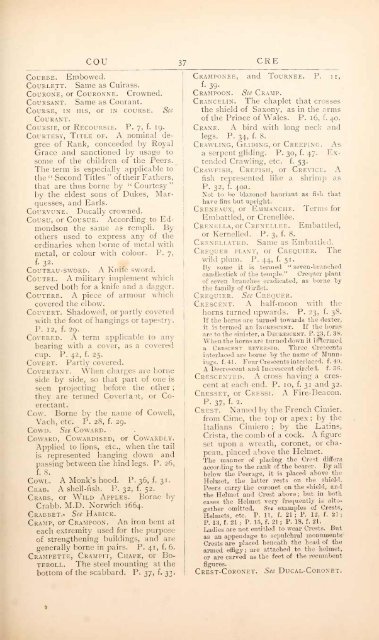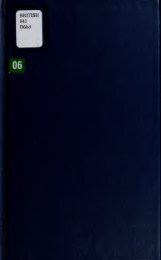You also want an ePaper? Increase the reach of your titles
YUMPU automatically turns print PDFs into web optimized ePapers that Google loves.
cou 37<br />
CouRBE. Embowed.<br />
CouRLEjT, Same as Cuirass.<br />
CouRONE, or CouRONNE. Crowncd.<br />
CouRSANT. Same as Courant.<br />
Course, in his, or in course. See<br />
Courant.<br />
CouRSiE, or Recoursie. p. 7, f. ig.<br />
Courtesy, Title of. A nommal degree<br />
of Rank, conceeded by Royal<br />
Grace and sanctioned by usage to<br />
some of the children of the Peers.<br />
The term is especially applicable to<br />
the " Second Titles " of their Fathers,<br />
that are thus borne by "Courtesy"<br />
by the eldest sons of Dukes, Marquesses,<br />
and Earls.<br />
Courvune. Ducally crowned.<br />
Cousu, or Cousue. According to Edmondson<br />
the same as rempli. By<br />
others used to express any of the<br />
ordinaries when borne of metal with<br />
metal, or colour with colour. P. 7,<br />
f. 32.<br />
CouTEAU-swoRD. A Knife sword.<br />
Coutel. a military implement which<br />
served both for a knife and a dagger.<br />
CouTERE. A piece of armour which<br />
covered the elbow.<br />
CouvERT. Shadowed, or partly covered<br />
with the foot of hangings or tapestry.<br />
P. 12, f. 29.<br />
Covered. A term applicable to any<br />
bearing with a cover, as a covered<br />
cup. P. 42, f. 25.<br />
Covert. Partly covered.<br />
CovERTANT. When charges are borne<br />
side by side, so that part of one is<br />
seen projecting before the other ;<br />
they are termed Covertant, or Coerectant.<br />
Cow. Borne by the name of Cowell,<br />
Vach, etc. P. 28, f. 29.<br />
CowD. See Coward.<br />
Coward, Cowardised, or Cowardly.<br />
Applied to lipns, etc., w^ien the tail<br />
is represented hanging dowm and<br />
passing between the hind legs. P. 26,<br />
f. 8.<br />
Cowl. A Monk's hood. P. 36, f. 31.<br />
Crab. A shell-fish. P. 32, f. 52.<br />
Crabs, or Wild Apples. Borne by<br />
Crabb, M.D. Norwich 1664.<br />
Crabbet.* See Habick.<br />
Cramp, or Crampoon. An iron bent at<br />
each extremity used for the purpose<br />
of strengthening buildings, and are<br />
generally borne in pairs. P. 41, f. 6.<br />
Crampette,<br />
TEROLL.<br />
Crampit, Chape, or Bo-<br />
The steel mounting at the<br />
bottom of the scabbard. P. f. 37, 33.<br />
CRE<br />
Cramponee, and Tournee. P. 11,<br />
f- 39-<br />
Crampoon. See Cramp.<br />
Crancelin. The chaplet that crosses<br />
the shield of Saxony, as in the arms<br />
of the Prince of Wales. P. 16, f. 40.<br />
Crane. A bird with long neck and<br />
legs. P. 34, f. 8.<br />
Crawling, Gliding, or Creeping. As<br />
a serpent gliding. P. f. 30, 47. Extended<br />
Crawling, etc. f. 53.<br />
Crawfish, Crefish, or Crevice. A<br />
fish represented like a shrimp as<br />
P. f.<br />
32, 40a.<br />
Not to be blazoned hanriant as fisli that<br />
have fins but upright.<br />
Creneaux, or Emmanche.<br />
Embattled, or Crenellee.<br />
Terms for<br />
Crenella, or Crenellee. Embattled,<br />
or Kernelled. P. f.<br />
3,<br />
8.<br />
Crenellated. Same as Embattled.<br />
Crequer plant, or Crequier. The<br />
wild plum. P. f.<br />
44, 51.<br />
By some it is teruied " seven-branched<br />
candlestick of the temple." Crequer plant<br />
of seven branches eradicated, as borne by<br />
the family of Girflet.<br />
Crequier. See Crequer.<br />
Crescent. A half-moon with the<br />
horns turned upwards. P. 23,<br />
f. 38.<br />
If the horns are turned towards the dexter,<br />
it is termed &n Increscent. If the horns<br />
are to the sinister, a Decrescent. P. 23, f. 38.<br />
When the horns are turned down it isT^ermed<br />
a Crescent reversed. Three Crescents<br />
interlaced are borne by the name of Munn-<br />
iugs.<br />
A Decrescent and Increscent circled, f. 3fi.<br />
Crescented. a cross having a crescent<br />
at each end. P. 10, f. 31 and 32.<br />
Cresset, or Cressi. A Fire-Beacon.<br />
P. f. 37, 2.<br />
the French Cimier,<br />
f. 41. Four Crescents interlaced, f . 40.<br />
Crest. Named by<br />
from Cime, the top or ; apex by the<br />
Italians Cimiero ; by<br />
the Latins,<br />
Crista, the comb of a cock. A figure<br />
set upon a wreath, coronet, or chapeau,<br />
placed above the Helmet.<br />
The manner of placing the Crest differs<br />
according to the rank of the bearer. By all<br />
below the Peerage, it is placed abovethe<br />
Helmet, the latter rests on the shield.<br />
Peers carry the coronet on the shield, and<br />
the Helmet and Crest above; but in both<br />
cases the Helmet very frequently is altogether<br />
omitted. See examples of Crests,<br />
Helmets, etc. P. H, f. 21; P. 12, f. 21;<br />
P. 13, f. 21; P. 15, f. 21; P. 18, f. 21.<br />
Ladies are not entitled to wear Crests. But<br />
as an appendage to sepulchral monuments<br />
Crests are placed beneath the head of the<br />
armed effigy; are attached to the helmet,<br />
or are carved as the feet of the recumbent<br />
figures.<br />
Crest-Coronet. See Ducal-Coronet.



